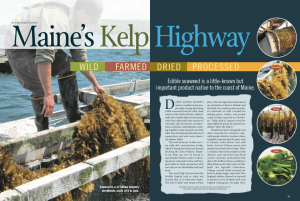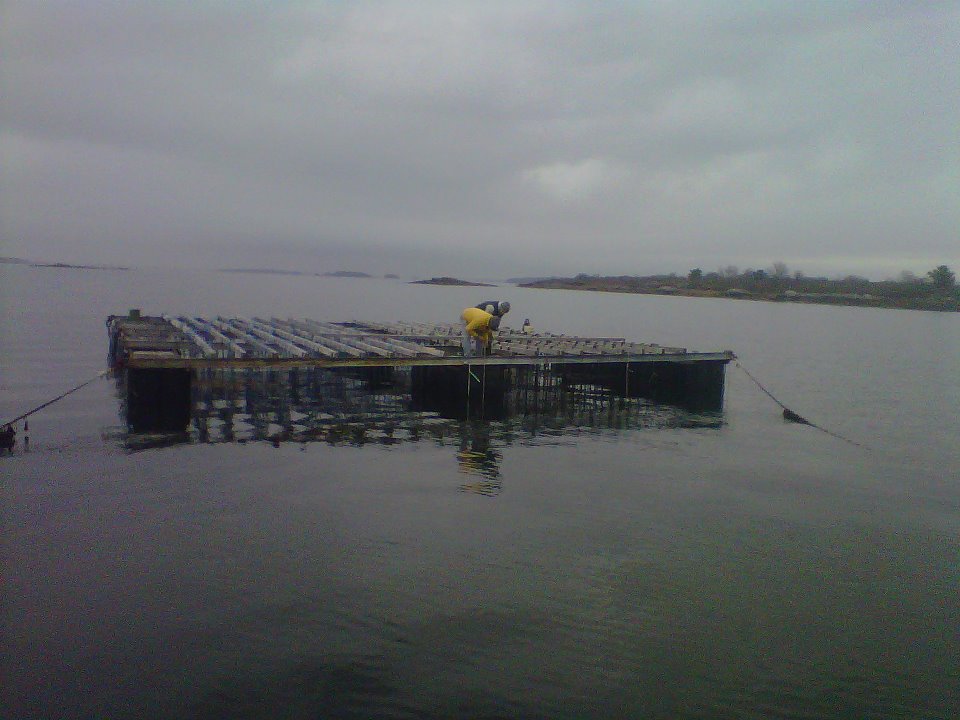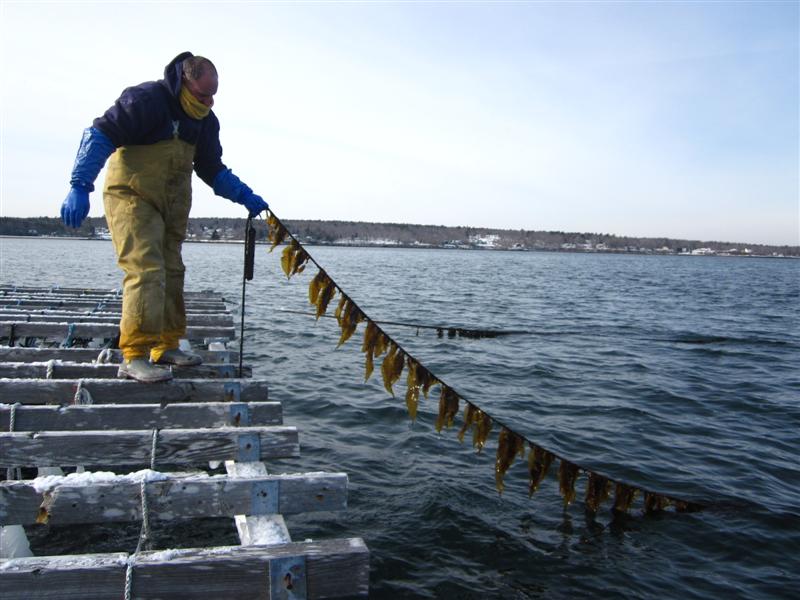A Pilot Project to Stimulate Seaweed Production on Mussel Farms in Maine
Seaweed is a $6 billion-dollar industry worldwide. Different types of seaweed (also called sea vegetables or marine macroalgae) are harvested for a variety of uses including fertilizer, food ingredients, and nutritional supplements.
Maine’s established seaweed companies are industry leaders, and more people are looking to grow seaweed as a business or for supplemental income.
Maine Sea Grant is working with Maine shellfish farmers to build expertise in growing kelp. With a grant of $19,999 from the Maine Aquaculture Innovation Center, Marine Extension Team members Dana Morse and Sarah Redmond are working with industry partners Pemaquid Mussel Farms (Carter Newell, Peter Fischer, Joe Larrabee, Tim Levesque), Erick Swanson of Maine Cultured Mussels, Inc., Evan Young of Blue Hill Bay Mussels, Matt Moretti of Wild Ocean Aquaculture, and Ocean Approved, the nation’s first commercial kelp producer. We are constructing a demonstration hatchery at the UMaine Center for Cooperative Aquaculture Research.
The project is a leading Integrated Multi-Trophic Aquaculture (IMTA) effort in the US to produce kelp on commercial mussel farms. The kelp species being grown is the sugar kelp, Latissima saccharina. Sugar kelp is native to Maine, grows quickly, and can be delivered into an existing and growing market, thanks to the know-how of Ocean Approved and wild harvesters. This species was chosen because of the existing know-how in producing seedlings, and the established market, both from Ocean Approved and wild harvesters. Sugar kelp is native to Maine, grows quickly, and can be delivered into a growing market. Through photosynthesis and growth, seaweeds remove carbon dioxide and nitrogen. Some strains of seaweed contain half their weight as oil, which represents a potential biofuel.
The project aims to accomplish several goals:
- Build expertise in kelp farming among shellfish farmers.
- Improve communications between kelp producers and buyers, and improve profitability for both sectors.
- Gather observations on environmental factors and growth, to improve site selection and production methods.
- Continue technology transfer on kelp production to other potential shellfish or seaweed farmers.
This project is also a notable opportunity to evaluate the profitability of growing kelp. Seaweed aquaculture holds promise as a potential option for fishermen who are looking to diversify their income, and keep working waterfronts active. As a winter crop, sugar kelp might be a product that lobstermen could grow in the ‘off season.’ It would use much of the same expertise and equipment, and the crop is ready in April-June, just at the point when many lobstermen are feeling the financial pinch.
Project partners began deploying seeded lines in November 2011 in Casco Bay, between the mussel rafts of Wild Ocean Aquaculture, owned by Matt Moretti. We will be expanding to other sites to evaluate kelp growth in Blue Hill Bay, Stonington, Lamoine, Belfast, and Walpole.
- Tollef Olson (Ocean Approved) and Matt Moretti (Wild Ocean Aquaculture) seeding kelp lines between Matt’s raft, November 2010. IMTA is underway! Photo: Paul Dobbins, Ocean Approved.
- On 22 January, after 54 days of growth, Paul Dobbins of Ocean Approved shows off the kelp on Matt Moretti’s site… looking good! The seedlings had blades of approximately 3mm at seeding. Photo: Ocean Approved.
For more information on the project, contact:
Dana Morse
Maine Sea Grant and UMaine Cooperative Extension
207.563.3146 x 205
Email
or our industry partners:
Matt Moretti
Wild Ocean Aquaculture
Phone: 207-458-6288 or Email
Find us on Facebook at Bangs Island Mussels
Project Updates:
December 17, 2011 – go to my shellfish blog for an update on getting four sites seeded in.
December 31, 2011: another update on the shellfish blog (address just above), as to why tech transfer is beneficial and fun, and why dogs are great.
Feb 1, 2012 – A total Blast and a great idea; the Smoked Mussel/Kelp Bento Box! Details on my blog at: http://danastravelingshellfishblog.blogspot.com/
2016: The Final Report to Maine Aquaculture Association
Other Resources:

Here’s a video from Dan Cheney, of the Pacific Shellfish Institute, on a project he’d done a while back, growing Macrocystis and Nereocystic, on the west coast: the techniques are similar, and there’s some good information about algal biology and structure…
Bord Iascaigh Mhara (BIM – Irish Sea Fisheries Board): A web page that lists some publications on kelp cultivation, market analysis, and business planning, as well as downloadable documents on aquaculture of other species.


